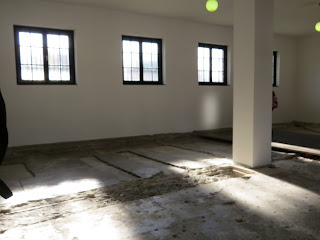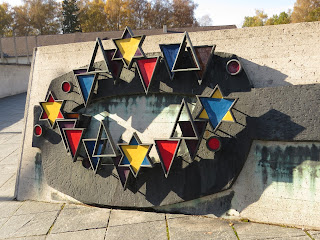While our entire trip in Germany was full of fun, castles, alps, adventures and beautiful parts of the country's history, our trip would not really be complete without visiting one of the most well known parts of the current history of the country. Unfortunately, this place does not highlight the best (some) of the people or history of Germany....but, it is part of the history, and should not be ignored.
Dachau.
The first established concentration camp in the country, which was originally built to hold political prisoners that opposed Hitler's party. Originally the grounds were an old munitions factory that closed down after the 1st World War when Germany was forbidden to build arms. The grounds were converted to a prison when Hilter's Socialist party needed a place to hold members of the opposition they began arresting in 1933. It was built to hold a max of 5,000 prisoners that would be used in forced labor. It ended up being the model for the approx. 300 sub-camps that were built throughout the country. This was Heinrich Himmler's main camp - due to its close proximity to Munich - so everything that was implemented in other camps throughout Europe started here.
Eventually, as the years went on, in addition to the political prisoners it held, the camp started housing gypsies, homosexuals, Polish & Russian POW's, as well as a number of Jews. The camp (which was to hold a max of 5,000 prisoners) ended up housing over 30,000 by the time it closed. Of the over 200,000 that came to this camp, 30,000 were liberated in 1945. The rest either died, were murdered, or transferred to a sub-camp - all during the almost 12 years it was open. Almost half of those that were liberated died within weeks of being freed, due to the extreme sickness, disease and malnutrition while at the camp.
We went on a tour of the camp today. Most of the buildings were destroyed after the camp was liberated. For years, the Germans hoped to erase the horrifying things that happened here. The camp was actually used as a prison for SS soldiers awaiting their own war crimes trials - under much better conditions that they provided for the own prisoners they kept there.
In the 60's it was converted to a Memorial site by one of the survivors. A couple of the original buildings that still stand are the receiving building where they people would come to be checked in and stripped of all their human rights and identities, the isolation rooms - where they would end up in isolation for days without food or water, the torture rooms - where prisoners would be interrogated, the original crematorium, the gas chamber, and some of the guard towers. The original barracks were all torn down, but the foundations remain and you could see those. Two were rebuild after the Memorial was opened for visitors to understand the living conditions at the time.
I decided not to post the pictures of some of the interiors of the buildings, out of respect. It is hard looking at them now. The crematorium and gas chambers were surreal. It is almost unbelievable that something like that could have happened in the same world we live - and not that long ago in our history. Walking through those rooms - you truly cannot imagine what happened here. Approx 41,000 lost their lives at this camp alone, in the most cruel and inhumane ways possible.
Our guide was extremely passionate about the tour and her job. She spent about 4 hours walking us through the camp and giving us a history lesson we could never imagine forgetting. At the end of the day, she left us with this saying, that I thought was perfect and something everyone should remember:
Do not apologize or feel responsible or guilty for what was done here. Instead, learn, and do what you can to make sure this never happens again.
It is true - there is nothing you can do to change the past and what happened here. But we should all learn from this and never let it be repeated. It is the best way to honor and show respect to those that died here.
 |
| Entrance to the camp. Prisoners entered this same building & gate. |
 |
| "Work will set you free" - The inscription on the gate. This was both propaganda for the people in the city of Dachau - as they did not know what was really going on in the camp. |
 |
| The receiving bldg. - this is the original shower room. |
 |
| Part of the memorial on the grounds |
 |
| View of the barracks |
 |
| Part of the Memorial depicting how the barbed wire fence looked |
 |
| Memorial - depicting the prisoners that were killed on the electrocuted barbed wire fence along the perimeter |
 |
| The patterns & colors represent the symbols and markings the guards gave to the prisoners based on what they were. |
 |
| Isolation room - but the windows were blacked out. |
 |
| Original torture chamber building |
 |
| Guard tower |
 |
| Each barracks had 2 poplar trees planted in front of it. They grow so fast & tall - this was to show the citizens outside the camp that the place was full of trees and well taken care of. |
 |
| Foundation of Barracks #6 |
 |
| Original crematorium |

























No comments:
Post a Comment